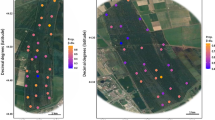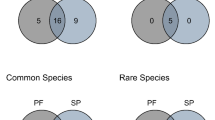Abstract
We used data from a light-trapping study at 28 sites on floodplain forest moths in eastern Austria to assess the performance of a variety of species richness and species diversity measures. At each site the data (32,181 individuals from 448 species) contain a large fraction of species represented only as singletons. Sampling effort was evenly spread across sites, but sampling success varied greatly. Influx of moths from the landscape matrix surrounding floodplain forest patches lead to substantial proportions of stray individuals from the regional species pool. Under these conditions, observed species numbers as well as eight extrapolation estimators of species totals failed to reflect differences between three study regions or between flooded and non-flooded forest habitats. Rarefied species numbers and Fisher’s α of the log-series distribution captured differences in moth diversity between regions, but failed to mirror flooding impact. Only Shannon’s diversity captured all expected diversity differences, at high significance levels. Application of Chao and Shen’s bias correction increased figures of Shannon’s diversity, but did not affect the outcome of statistical comparisons. We conclude that for species-rich incompletely sampled communities of highly mobile insects the evaluation of the complete species-abundance information using Shannon’s diversity is the most promising mode to compare local species diversity with a high degree of ecological resolution. Species richness measures apart from those obtained through rarefaction cannot be recommended, as they are sensitive to sources of bias that pertain to many empirical sets of field data.

Similar content being viewed by others
References
Anderson MJ, Gorley RN, Clarke KR (2006) PERMANOVA+ for PRIMER: guide to software and statistical methods. Primer-E Ltd., Plymouth
Ballinger A, Lake P, Nally R (2007) Do terrestrial invertebrates experience floodplains as landscape mosaics? Immediate and longer-term effects of flooding on ant assemblages in a floodplain forest. Oecologia 152:227–238
Beck J, Schwanghart W (2010) Comparing measures of species diversity from incomplete inventories: an update. Methods Ecol Evol 1:38–44
Beck J, Schulze CH, Linsenmair KE, Fiedler K (2002) From forest to farmland: diversity of geometrid moths along two habitat gradients on Borneo. J Trop Ecol 18:33–51
Brose U, Martinez ND (2004) Estimating the richness of species with variable mobility. Oikos 105:292–300
Brose U, Martinez ND, Williams RJ (2003) Estimating species richness: sensitivity to sample coverage and insensitivity to spatial patterns. Ecology 84:2364–2377
Buckland ST, Magurran AE, Green RE, Fewster RM (2005) Monitoring change in biodiversity through composite indices. Philos Trans R Soc Lond B 360:243–254
Cayuela L, Golicher DJ, Benayas JMR, González-Espinosa M, Ramírez-Marcial N (2006) Fragmentation, disturbance and tree diversity conservation in tropical montane forests. J Appl Ecol 43:1172–1181
Chao A, Shen TJ (2003) Nonparametric estimation of Shannon’s index of diversity when there are unseen species in sample. Environ Ecol Stat 10:429–443
Chao A, Shen TJ (2009) SPADE (species prediction and diversity estimation). http://chao.stat.nthu.edu.tw. Accessed 04 Nov 2011
Clarke KR, Gorley RN (2006) Primer v6: user manual/tutorial. Primer-E Ltd., Plymouth
Colwell RK (2009) EstimateS: statistical estimation of species richness and shared species from samples. Version 8.2. User’s guide and application. http://viceroy.eeb.uconn.edu/estimates. Accessed 01 Oct 2011
Colwell RK, Coddington A (1994) Estimating terrestrial biodiversity through extrapolation. Philos Trans R Soc Lond B 345:101–118
Colwell RK, Mao CX, Chang J (2004) Interpolating, extrapolating, and comparing incidence-based species accumulation curves. Ecology 85:2717–2727
Coscaron M, Melo M, Coddington J, Corronca J (2009) Estimating biodiversity: a case study on true bugs in Argentinian wetlands. Biodivers Conserv 18:1491–1507
Crist TO, Veech JA, Gering JC, Summerville KS (2003) Partitioning species diversity across landscapes and regions: a hierarchical analysis of α β and γ diversity. Am Nat 162:734–743
Danielsen F, Beukema H, Burgess ND, Parish F, Brühl CA, Donald PF, Murdiyarso D, Phalan BEN, Reijnders L, Struebig M, Fitzherbert EB (2009) Biofuel plantations on forested lands: double jeopardy for biodiversity and climate. Conserv Biol 23:348–358
Fiedler K, Schulze CH (2004) Forest modification affects diversity (but not dynamics) of speciose tropical pyraloid moth communities. Biotropica 36:615–627
Fisher RA, Corbet AS, Williams CB (1943) The relation between the number of species and the number of individuals in a random sample of an animal population. J Anim Ecol 12:42–58
Irmler U, Arp H, Nötzold R (2010) Species richness of saproxylic beetles in woodlands is affected by dispersion ability of species, age and stand size. J Insect Conserv 14:227–235
Jost L (2006) Entropy and diversity. Oikos 113:363–375
Jost L (2007) Partitioning diversity into independent alpha and beta components. Ecology 88:2427–2439
Lazowski W (1997) Auen in Österreich: Vegetation, Landschaft und Naturschutz. Monographien 81. Umweltbundesamt. Federal Environment Agency, Vienna
Longino JT, Coddington J, Colwell RK (2002) The ant fauna of a tropical rain forest: estimating species richness three different ways. Ecology 83:689–702
Magurran AE (2004) Measuring biological diversity. Afr J Aquat Sci 29:285–286
Magurran AE (2007) Species abundance distributions over time. Ecol Lett 10:347–354
Magurran AE, Henderson PA (2003) Explaining the excess of rare species in natural species abundance distributions. Nature 422:714–716
Moritz T, Krishnan S, Roberts D, Ingwersen P, Agosti D, Penev L, Cockerill M, Chavan V (2011) Towards mainstreaming of biodiversity data publishing: recommendations of the GBIF Data Publishing Framework Task Group. BMC Bioinformatics 12(Suppl 15):S1
Mutanen M, Wahlberg N, Kaila L (2010) Comprehensive gene and taxon coverage elucidates radiation patterns in moths and butterflies. Proc R Soc Lond B 277:2839–2848
Pöyry J, Paukkunen J, Heliölä J, Kuussaari M (2009) Relative contributions of local and regional factors to species richness and total density of butterflies and moths in semi-natural grasslands. Oecologia 160:577–587
Reiss J, Bridle JR, Montoya JM, Woodward G (2009) Emerging horizons in biodiversity and ecosystem functioning research. Trends Ecol Evol 24:505–514
Rosenzweig ML (1999) Heeding the warning in biodiversity’s basic law. Science 284:276–277
Sattler T, Duelli P, Obrist M, Arlettaz R, Moretti M (2010) Response of arthropod species richness and functional groups to urban habitat structure and management. Landsc Ecol 25:941–954
Summerville KS, Crist TO (2005) Temporal patterns of species accumulation in a survey of Lepidoptera in a beech-maple forest. Biodivers Conserv 14:3393–3406
Thomas AW, Thomas GM (1994) Sampling strategies for estimating moth species diversity using a light trap in a northeastern softwood forest. J Lepid Soc 48:85–105
Tockner K, Schiemer F, Ward JV (1998) Conservation by restoration: the management concept for a river-floodplain system on the Danube River in Austria. Aquat Conserv Marine Freshw Ecosyst 8:71–86
Truxa C, Fiedler K (2012) Down in the flood? How moth communities are shaped in temperate floodplain forests. Insect Conserv Divers 5. doi:10.1111/j.1752-4598.2011.00177.x
Vormisto J, Svenning JC, Hall P, Balslev H (2004) Diversity and dominance in palm (Arecaceae) communities in terra firme forests in the western Amazon basin. J Ecol 92:577–588
Waite TA, Campbell LG (2006) Controlling the false discovery rate and increasing statistical power in ecological studies. Ecoscience 13:439–442
Wei SG, Li L, Walther B, Ye WH, Huang ZL, Cao HL, Lian JY, Wang ZG, Chen YY (2010) Comparative performance of species-richness estimators using data from a subtropical forest tree community. Ecol Res 25:93–101
Whittaker RH (1972) Evolution and measurement of species diversity. Taxon 21:213–251
Wilson WG, Lundberg P (2004) Biodiversity and the Lotka–Volterra theory of species interactions: open systems and the distribution of logarithmic densities. Proc R Soc Lond B 271:1977–1984
Zillio T, Condit R (2007) The impact of neutrality, niche differentiation and species input on diversity and abundance distributions. Oikos 116:931–940
Zillio T, He F (2010) Inferring species abundance distribution across spatial scales. Oikos 119:71–80
Acknowledgments
We thank Florian Bodner, Jan Beck, Gunnar Brehm and two anonymous reviewers for helpful comments on an earlier manuscript draft. Ottokar Jindrich (Austrian Armed Forces), Gerhard Neuhauser (WWF), Christian Baumgartner (Nationalpark Donau-Auen) and Peter Jansen (Harrach’sche Forstverwaltung) kindly granted access to study sites.
Author information
Authors and Affiliations
Corresponding author
Rights and permissions
About this article
Cite this article
Fiedler, K., Truxa, C. Species richness measures fail in resolving diversity patterns of speciose forest moth assemblages. Biodivers Conserv 21, 2499–2508 (2012). https://doi.org/10.1007/s10531-012-0311-5
Received:
Accepted:
Published:
Issue Date:
DOI: https://doi.org/10.1007/s10531-012-0311-5




